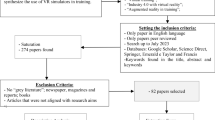Abstract
Due to real world physical constraints (e.g. walls), experimenting a virtual reality phenomenon implies transitional issues from one virtual environment (VE) to another. This paper proposes an experiment which studies the relevance of smooth and imperceptible transitions from a familiar and pleasurable virtual environment to a similar workplace as a mean to avoid traumatic experiences in VR for trainees. Specifically, the hereby work assumes that the user consciousness regarding virtual environment transitions is a relevant indicator of positive user experience during those. Furthermore, serious games taking place in purely virtual environments have the advantage of coping with various workplace configurations and tasks that the trainee can practice. However, the virtual world of serious games should be carefully designed in order to avoid traumatic experiences for trainees. The results presented stem from an empirical evaluation of user experience conducted with 80 volunteers. This evaluation shows that more than one-third of the participants did not even notice the VE global change.
Access this chapter
Tax calculation will be finalised at checkout
Purchases are for personal use only
Similar content being viewed by others
References
Johansson, E.: Dreamwalking...in between worlds (2014)
INRS: Troubles musculosquelettiques (TMS). Statistiques. http://www.inrs.fr/risques/tms-troubles-musculosquelettiques/statistiques.html
Bevan, S.: Economic impact of musculoskeletal disorders (MSDs) on work in Europe. Best Pract. Res. Clin. Rheumatol. 29, 356–373 (2015). doi:10.1016/j.berh.2015.08.002. Elsevier
Bartolom, N.A., Zorrilla, A.M., Zapirain, B.G.: Can game-based therapies be trusted? Is game-based education effective? A systematic review of the serious games for health, education. In: 6th International Conference on Computer Games (CGAMES), pp. 275–282. IEEE (2011). doi:10.1109/CGAMES.2011.6000353
Ma, M., Zheng, H.: Virtual reality and serious games in healthcare. In: Brahnam, S., Jain, L.C. (eds.) Advanced Computational Intelligence Paradigms in Healthcare 6. Virtual Reality in Psychotherapy, Rehabilitation, and Assessment, vol. 337, pp. 169–192. Springer, Heidelberg (2011). doi:10.1007/978-3-642-17824-5_9
Gobron, S.C., Zannini, N., Wenk, N., Schmitt, C., Charrotton, Y., Fauquex, A., Lauria, M., Degache, F., Frischknecht, R.: Serious games for rehabilitation using head-mounted display and haptic devices. In: Paolis, L.T., Mongelli, A. (eds.) AVR 2015. LNCS, vol. 9254, pp. 199–219. Springer, Cham (2015). doi:10.1007/978-3-319-22888-4_15
Sportillo, D., Avveduto, G., Tecchia, F., Carrozzino, M.: Training in VR: a preliminary study on learning assembly/disassembly sequences. In: Paolis, L.T., Mongelli, A. (eds.) AVR 2015. LNCS, vol. 9254, pp. 332–343. Springer, Cham (2015). doi:10.1007/978-3-319-22888-4_24
Martin, C.C., Burkert, D.C., Choi, K.R., Wieczorek, N.B., McGregor, P.M., Herrmann, R.A., Beling, P.A.: A real-time ergonomic monitoring system using the Microsoft Kinect. In: 2012 IEEE Systems and Information Design Symposium (SIEDS), pp. 50–55. IEEE (2012). doi:10.1109/SIEDS.2012.6215130
Haggag, H., Hossny, M., Nahavandi, S., Creighton, D.: Real time ergonomic assessment for assembly operations using Kinect. In: 15th International Conference on Computer Modelling and Simulation (UKSim), pp. 495–500. IEEE (2013). doi:10.1109/UKSim.2013.105
Johnson, D., Deterding, S., Kuhn, K.A., Staneva, A., Stoyanov, S., Hides, L.: A systematic review of the literature. In: Internet Interventions, vol. 6, pp. 89–106. Elsevier (2016). doi:10.1016/j.invent.2016.10.002
Daesign: La pédagogie numérique au service des apprenants, des entreprises et des professionnels de la formation. http://www.daesign.com/
Rodrigues, M.A.F., Macedo, D.V., Pontes, H.P., Serpa, Y.R., Serpa, Y.R.: A serious game to improve posture and spinal health while having fun. In: 2016 IEEE International Conference on Serious Games and Applications for Health (SeGAH), pp. 1–8. IEEE (2016). doi:10.1109/SeGAH.2016.7586260
Saenz-De-Urturi, Z., Garcia-Zapirain Soto, B.: Kinect-based virtual game for the elderly that detects incorrect body postures in real time. In: Sensors for Entertainment, Sensors (2016). doi:10.3390/s16050704
Barrett, P., Zhang, Y., Moffat, J., Kobbacy, K.: A holistic, multi-level analysis identifying the impact of classroom design on pupils’ learning. Build. Environ. J. 59, 678–689 (2013). doi:10.1016/j.buildenv.2012.09.016. Elsevier
Sakellaris, I.A., Saraga, D.E., Mandin, C., Roda, C., Fossati, S., de Kluizenaar, Y., Carrer, P., Dimitroulopoulou, S., Mihucz, G.V., Szigeti, T., Hnninen, O., de Oliveira Fernandes, E., Bartzis, J.G., Bluyssen, P.M.: Perceived indoor environment and occupants’ comfort in European “modern” office buildings: the OFFICAIR study. Int. J. Environ. Res. Public Health 13, 4:1–4:15 (2016). doi:10.3390/ijerph13050444. MDPI
Al Horr, Y., Arif, M., Katafygiotou, M., Mazroei, A., Kaushik, A., Elsarrag, E.: Impact of indoor environmental quality on occupant well-being and comfort: a review of the literature. Int. J. Sustain. Built Environ. 5, 1–11 (2016). doi:10.1016/j.ijsbe.2016.03.006. Elsevier
Zelenski, J.M., Murphy, S.A., Jenkins, D.A.: The happy-productive worker thesis revisited. J. Happiness Stud. 9, 521–537 (2008). doi:10.1007/s10902-008-9087-4. Springer, Netherlands
Kaplan, S.: Toward an integrative framework. J. Environ. Psychol. 15, 169–182 (1995). doi:10.1016/0272-4944(95)90001-2. Academic Press Limited
INRS: Troubles musculosquelettiques (TMS). Facteurs de risque. http://www.inrs.fr/risques/tms-troubles-musculosquelettiques/facteurs-risque.html
Unity Game Engine. https://unity3d.com/
Unity Asset Store. https://www.assetstore.unity3d.com/en/
Blender. https://www.blender.org/
HTC Corporation. https://www.vive.com
Simons, D.: But Did You See the Gorilla? The Problem With Inattentional Blindness. In: Smithsonian Magazine (2012)
Acknowledgement
This work was supported by the EU Interreg program, grant number (contract no.1812) as a part of the SG4H@W project. We would like to thank all the health professionals that took part in the investigation or contributed otherwise to this project; many thanks also to the CHUV (University Hospital of Canton Vaud, Switzerland) for its help and advice.
Author information
Authors and Affiliations
Corresponding author
Editor information
Editors and Affiliations
Rights and permissions
Copyright information
© 2017 Springer International Publishing AG
About this paper
Cite this paper
Sisto, M., Wenk, N., Ouerhani, N., Gobron, S. (2017). A Study of Transitional Virtual Environments. In: De Paolis, L., Bourdot, P., Mongelli, A. (eds) Augmented Reality, Virtual Reality, and Computer Graphics. AVR 2017. Lecture Notes in Computer Science(), vol 10324. Springer, Cham. https://doi.org/10.1007/978-3-319-60922-5_3
Download citation
DOI: https://doi.org/10.1007/978-3-319-60922-5_3
Published:
Publisher Name: Springer, Cham
Print ISBN: 978-3-319-60921-8
Online ISBN: 978-3-319-60922-5
eBook Packages: Computer ScienceComputer Science (R0)




